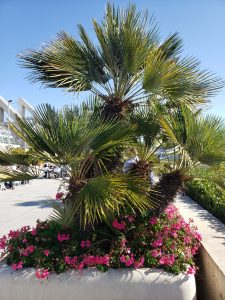Last week this was my view.

This week nothing but wintry snow and cold everywhere.

Oh, how I miss the sunnier climes of San Diego. I think I will add one more resolution to my first blog, spend some time every winter somewhere sunny, as this cold really gets into the bones. Anyways, I wasn’t simply in San Diego to look on in wonderment at palm trees. No I was there to learn about robots. More specifically, automation equipment for the lab, how we can make things faster, how robot arms in a lab can work with 500 cell-lines, do a thousand reactions a minute, all while making a pot of tea for me, and figuring out what we think about our latest data. Is this science fiction, no its reality. In fact, this was a glimpse into all the latest lab automation technology on display at this years annual SLAS meeting, otherwise known as the “Society for Lab Automation and Screening”. And can I say, my mind was blown. The technologies coming down the pipeline to analyze one single cell, all the way to growing a million organoids with new AI algorithms for analyzing all the data from these cells is not five years away. It’s already here. And ready to make our daily lab lives easier.
So are the machines taking over. Is it like Terminator 2? Are the machines ready to take over. Well I will be blunt, no. I arrive back in Montreal, and one of our fridges in the lab stops working. Just you know, no longer keeps things cold. Its now fixed, so yay. Then a few day later, a -80 freezer decides to crash on us. Oh, how I wish I was back in sunshine, where the machines worked wonders, here are freezers have issues staying operational, thank god for backup freezers ready to take over when one crashes. Anyways, my take on it all, machines and technology are good, but they won’t take over, they need us to repair them, and to make sure they are used properly. And I should never leave the lab again, when I leave, things break.
So I was delayed in blogging/social mediaing with all the travel over the past few weeks but am now back in Montreal and over the coming weeks will be writing more content as we release new work from the lab. For this week however, I wanted to bring peoples attention to two great pieces of work from elsewhere:
- Snake venom organoids: This is literally the coolest thing I have seen, its phenomenal work. Now we have a way to study snake venom in a dish. I think this will be a very powerful tool and I can’t wait to see what comes next from this group
- Minibrains aren’t brains: A well designed study in Nature came out last week showing that 3D neuronal organoids or minibrains were not in fact miniature brains, and were also stressed. This confirms what we all suspected for a long time, but this opportunity opens the door for new work moving forward with 3D neuronal organoids.
To finish, I also have to say thank you to CIHR, or the Canadian Institute for Health Research, two weeks ago I got the great news that my project grant was funded, this was my view from Vancouver airport as I waited to board my flight when I got the news, top 10 happiest moments of my life that is for sure.

I took a picture of where I was so I would always remember where I was when I got my first CIHR research grant. I never got a CIHR grant before, or NIH funding or federal funding from any other country for that matter. I always found alternative ways to fund my work, but I was never able to convince these federal granting agencies that my work was fundable. With the CIHR decision, it feels like finally myself and my group are on the right way, vindicating my decision to become a scientist nearly two decades ago. You never forgot your first big grant, and I sure won’t, so thank you reviewers, colleagues, work team and everyone else for all their support, and also a special thank you to Vancouver airport, my new favourite airport.
This also means I can now cross one resolution from my list, I obtained a research grant as a research scientist. So, one down, nine resolutions to go. In the coming days, I will next be discussing the work ongoing on CRISPR genome editing in my group, and the tools we are making available. So stay tuned.
